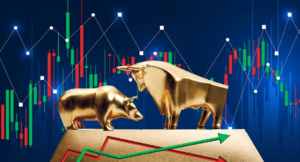How Interest Rate Changes Influence Asset Prices

Interest rates represent the cost of borrowing money or the return earned on savings. Central banks, such as the Federal Reserve or the European Central Bank, adjust interest rates to control inflation, stimulate economic growth, or stabilize the economy during periods of uncertainty. These changes ripple through financial markets, affecting stocks, currencies, bonds, and commodities.
In CFD trading, traders closely monitor interest rate decisions and expectations, as they often lead to significant price movements in the underlying assets.
How Interest Rate Changes Impact Asset Prices
1. Stocks
Interest rate hikes tend to negatively affect stock prices, especially for companies with high debt levels. Higher borrowing costs reduce corporate profitability, which can lead to lower stock valuations. Growth-oriented sectors like technology are often hit harder during rising interest rate environments.
Conversely, lower interest rates make borrowing cheaper, encouraging business expansion and boosting investor confidence in equities. This dynamic often leads to bullish trends in stock markets. Traders in online CFD trading can capitalize on these shifts by taking long or short positions on indices or individual stocks, depending on the direction of the rate change.
2. Forex Markets
Interest rate changes directly influence currency values. Higher interest rates attract foreign investment, strengthening the currency as demand increases. Conversely, rate cuts often weaken the currency due to reduced investor returns.
For example, if the Bank of England raises interest rates, the British pound may appreciate against other currencies. Traders in CFD trading can use this opportunity to speculate on forex pairs involving the pound.
3. Commodities
Interest rates also impact commodity prices, albeit indirectly. Higher rates strengthen currencies, which can make dollar-denominated commodities like gold and oil more expensive for international buyers, reducing demand and prices.
However, during periods of economic uncertainty, commodities like gold often rise in value as safe-haven assets, regardless of interest rate trends. Traders involved in online CFD trading frequently monitor these relationships to identify trading opportunities in commodity markets.
4. The Role of Central Banks
Central banks play a critical role in shaping interest rate policies. They adjust rates based on economic conditions, such as inflation levels, employment rates, and GDP growth. For traders, central bank announcements and policy meetings are essential events to follow, as they often trigger market volatility.
For instance, the Federal Reserve’s decision to raise interest rates might lead to a sell-off in equities while boosting the US dollar. In CFD trading, such events create opportunities to trade both rising and falling markets.
Strategies for Trading Interest Rate Changes
1. Stay Updated on Economic Calendars
Economic calendars highlight key events like central bank meetings and rate decisions. Monitoring these events allows traders to anticipate potential market reactions.
2. Use Risk Management Tools
Interest rate changes can lead to significant volatility. Tools like stop-loss orders and position sizing are essential to managing risks in online CFD trading.
3. Focus on Affected Assets
Identify assets most likely to react to interest rate changes, such as forex pairs, stock indices, and commodities. This targeted approach helps refine trading strategies.
4. Analyze Market Expectations
Market movements often reflect expectations rather than actual rate changes. If a rate hike is widely anticipated, its impact may already be priced in, reducing market volatility.
5. Practical Example
Consider a scenario where the European Central Bank signals an impending rate hike to combat inflation. Traders anticipate a stronger euro and take long positions on EUR/USD through CFD trading. At the same time, they might short European stock indices, expecting higher rates to reduce corporate earnings.
This example illustrates how understanding interest rate changes and their effects on multiple asset classes can help traders build comprehensive strategies.
Interest rate changes are a fundamental driver of market behavior, influencing asset prices across stocks, currencies, and commodities. For those engaged in online CFD trading, understanding the relationship between interest rates and market movements is essential to identifying opportunities and mitigating risks.







